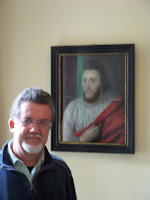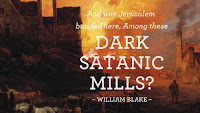Part I: The Grail Achieved
At last! The months of effort have been rewarded. With the generosity of our friend Jo and a great deal of luck, we have not only tasted the coveted
Westvleteren 12, we have purchased some.
But how? you ask, eyes wide and mouth agape. You could not raise the monks by telephone. How have you managed such a feat?
 |
| Grotto at Westvleteren |
Here's the tale: We spent Sunday night at Jo's seaside place, and on Monday he drove us to the Abbey of St. Sixtus, where we knew the attached cafe would sell us a glassful of the 12 (there is also a blond and an 8). There was quite a crowd, some who'd gotten through to the monks on the phone and had come to pick up their beer (many driving Porsches and Mercedeses) and some visiting because the abbey also has a grotto fashioned after the grotto in Lourdes, where people go to be healed. In fact, a large contingent in wheelchairs came in to have lunch, drink beers, and get healed while we were there. Anyway, we ordered lunch and three 12s.
The beer came. We drank.
Indeed, dear reader, it was ambrosial. We agreed that even taking into account the absurd amount of hype, the Westvleteren 12 is a truly special beer. Very possibly the best in the world, though we have a few more to try before we can make that judgment.
Our waitress told us that occasionally they sell a few bottles in the gift shop, but there were no extras today. This made Phil a little sad. So I coralled a waiter and asked him if maybe, possibly, there was a bottle lurking somewhere that he could sell us, as we had come from America to taste the beer. "Ah," he replied, "look! They are selling a few right now. If you hurry you can get some." And it was true! A line of people had suddenly materialized at the gift shop (how did they know?) and they were selling a very limited number of gift packs of 4 beers, including one 12, and a glass for an outrageous price. So we bought two gift packs.
And, borne by hands unseen, they all beheld
A chalice with a light veil over it --
The Holy Grale glide through the lighted hall.
Part II: By the Beautiful Sea
Before this miracle, we spent a glorious day at the seaside, where we hiked (8 miles total!) on the beach and were lucky enough to see a local oddity, the
horse fishermen of Oostduinkerke. They trawl for shrimp in the waves on their massive Belgian draft horses. Very peculiar and wonderful.
 |
| Veurne |
Jo cooked for us and the next day drove us all over West Flanders. We visited the beautiful town of Veurne, made our miraculous stop at Westvleteren, and then headed for Diksmuide.
Part III: In Flanders Fields
This strange-looking tower in Diksmuide has an equally strange history. It is part World War I history museum, part peace park, and part commemoration of the rise of Flemish nationalism. Flanders, as you no doubt know, was the site of terrible battles in World War I. At that time the country was run politically by the French-speaking Walloons, and the Flemish were often treated as second-class citizens. When the king asked the Flemish to fight in the war, he promised them equality at war's end -- but he did not keep his promise.
 |
| View from Yser Tower |
As a result, a powerful movement grew up, immortalized in the abbreviation on the tower: AVVVK, "All for Flanders, Flanders for Christ." This abbreviation was carved in the headstones of the Flemish soldiers who fell during the war. The first tower was blown up in 1946 -- some say by Walloon nationalists -- but was soon rebuilt.
 |
| World War I trench |
The museum inside the tower chronicles the horrors of the war in Flanders in a way that makes the devastation it inflicted all too clear. It's something that we in the US rarely think about.
As you can imagine, we are still reeling from our visit to West Flanders. A beery miracle, shrimp-fishing horses, World War I -- it's a lot to take in. We will mull it over while consuming our Westvletern.
"Fair sirs, great marvels have we seen to-day,
The Holy Grale we happy men have seen,
Which some deemed lost for ever to this earth."
 After that, we went to the Dar Si Said Museum, in a 19th century palace. The sultan who lived there had four wives and eight concubines. When troupes of dancing men performed for the sultan, the women watched through screens upstairs, looking down and across into mirrors that reflected the dancers so they didn't look directly at the men.
After that, we went to the Dar Si Said Museum, in a 19th century palace. The sultan who lived there had four wives and eight concubines. When troupes of dancing men performed for the sultan, the women watched through screens upstairs, looking down and across into mirrors that reflected the dancers so they didn't look directly at the men. 






















































